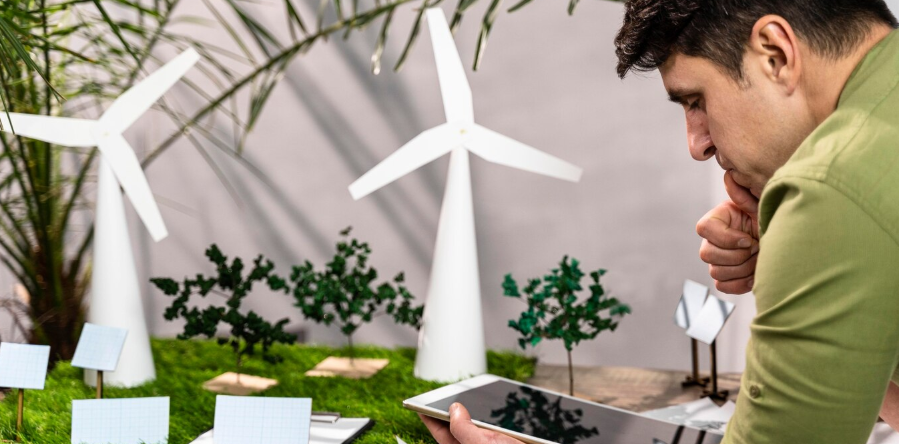Virtual Reality (VR) has quickly moved from being a futuristic technology to a tool with real-world applications, especially in education. By immersing students in fully interactive digital environments, VR has the potential to revolutionize how knowledge is delivered and experienced. Rather than learning from textbooks or watching videos, students can now actively engage with their lessons in a more dynamic, interactive, and immersive way.
In this article, we’ll explore how VR is changing education, the benefits it offers, its challenges, and the exciting future it holds for the learning process.
What is Virtual Reality in Education?
Virtual Reality (VR) in education refers to the use of VR technologies to create simulated environments where students can interact with and experience content in ways that traditional methods can’t replicate. Using VR headsets, students can enter a virtual world that might be anything from a historical landmark to the surface of Mars, or even a complex molecular structure. These virtual environments can be used for a wide range of educational purposes, from history lessons to advanced science training.
The experience is immersive, often interactive, and can be designed to cater to different learning styles and needs. With VR, education becomes more engaging, memorable, and accessible.
Benefits of Virtual Reality in Education
1. Immersive Learning Experiences
One of the most obvious advantages of VR in education is its ability to provide immersive learning experiences. Students can engage with the subject matter in a way that feels real, allowing them to understand concepts more deeply and retain information longer.
- Hands-On Learning: VR allows for simulated hands-on experiences. For example, in medical training, VR can give students the opportunity to practice surgery or diagnose patients in a controlled, risk-free virtual environment.
- Exploration: Students can explore environments that are otherwise inaccessible, like ancient civilizations, outer space, or the ocean floor, enriching their understanding of these subjects.
2. Increased Engagement and Motivation
Traditional teaching methods may struggle to hold students’ attention in the digital age, where technology is central to daily life. VR provides an engaging alternative, making learning both fun and stimulating. By adding an element of play and adventure to the process, VR can increase students’ motivation and curiosity.
- Gamification: Educational VR programs often incorporate elements of gaming, such as achievements, rewards, and challenges, encouraging students to stay engaged and enjoy the learning process.
- Active Participation: Rather than passively absorbing information, students become active participants in their learning, which can increase their interest and enthusiasm.
3. Personalized Learning
Every student learns differently. While some may thrive with traditional classroom methods, others might struggle to grasp certain concepts. VR can accommodate these different learning styles by providing customizable experiences that cater to individual needs.
- Pacing: With VR, students can learn at their own pace. They can pause, replay, or skip through content as needed, allowing them to focus on the areas where they need more practice.
- Adaptive Learning: VR programs can be designed to adjust difficulty levels or provide personalized feedback, helping students progress based on their abilities and needs.
4. Safe Learning Environments
Certain fields of study involve risks, such as medicine, engineering, or chemistry, where mistakes can be costly or dangerous. VR offers a safe environment to practice and experiment without real-world consequences.
- Simulated Experiments: In science education, students can conduct virtual chemistry experiments without the need for hazardous chemicals. Medical students can practice surgeries in a VR simulation, reducing the risk of mistakes when they perform real-life procedures.
- Risk-Free Exploration: Students can explore dangerous environments, such as volcanoes or the deep sea, in a controlled VR setting, allowing them to experience these environments without any physical risk.
5. Global Collaboration and Learning
Another benefit of VR in education is the ability to facilitate collaboration between students from different parts of the world. Virtual classrooms and collaborative VR spaces allow students to work together on projects and share learning experiences, no matter where they are located.
- Virtual Field Trips: Students can travel to historical sites, museums, or natural wonders through VR, all from their classroom, giving them a global perspective without the cost or logistical challenges of real-world travel.
- Cross-Cultural Exchange: VR opens the doors to immersive cultural exchange programs, where students can interact with peers from around the globe, experiencing other cultures firsthand.
Applications of VR in Education
The uses of VR in education span across various subjects and fields of study. Below are some examples of how VR is being utilized to enhance learning in specific disciplines:
1. Science and Medicine
VR has incredible potential in science and medicine, where students need to visualize and interact with complex systems. Medical students can practice surgery in a simulated environment, and biology students can explore the inside of the human body in ways that are impossible with traditional teaching methods.
- Anatomy: Students can view and interact with a 3D model of the human body, learning about its organs, systems, and structures.
- Surgical Training: Surgeons can perform simulated operations, gaining experience without any risks to actual patients.
2. History and Social Studies
History lessons come alive with VR, enabling students to virtually travel back in time to explore ancient civilizations, famous battles, or historical events. These immersive experiences provide a deeper understanding of the context and significance of history, engaging students in a way that textbooks cannot.
- Virtual Tours: Students can visit landmarks like the pyramids in Egypt, the Great Wall of China, or the Colosseum in Rome, all through virtual reality.
- Historical Reenactments: VR can allow students to witness major historical events in an interactive, immersive format, such as experiencing life in ancient Rome or participating in the signing of the Declaration of Independence.
3. Engineering and Architecture
Engineering students can benefit from VR by simulating the design and construction of complex structures. VR allows them to test their designs in a virtual environment before they ever create a physical prototype.
- Prototyping: Engineering students can interact with 3D models of machines, vehicles, or buildings, making adjustments and learning how design changes affect the final product.
- Virtual Building: Architecture students can use VR to walk through their designs and get a sense of scale, layout, and structure before construction begins.
4. Art and Design
VR can transform how art and design students create and critique their work. 3D modeling and sculpting programs allow students to craft sculptures or architectural designs directly in virtual environments, giving them new avenues for creativity and expression.
- Sculpture and Painting: VR tools such as Tilt Brush let artists create immersive 3D artwork, offering new creative opportunities that were previously not possible with traditional media.
- Virtual Museums and Exhibitions: Students can experience artwork in virtual museums or even curate their own exhibitions, offering a richer experience than simply viewing works online.
5. Language Learning
Learning a new language can be challenging, especially when it comes to immersion. VR can simulate real-world environments where students practice their language skills by interacting with virtual characters or navigating virtual spaces.
- Virtual Conversations: Students can practice speaking a new language by engaging in conversations with AI-driven avatars or role-playing situations, such as ordering food in a restaurant or asking for directions.
- Cultural Immersion: Students can “travel” to countries where the language is spoken, interacting with virtual locals to enhance their cultural understanding.
Challenges of Implementing VR in Education
While the potential for VR in education is immense, there are several challenges to its widespread adoption.
1. Cost and Accessibility
The cost of VR headsets and software can be prohibitive for many schools, especially in lower-income areas. While prices have been decreasing, high-quality VR systems can still be expensive for educational institutions to purchase in large quantities.
2. Content Creation and Curriculum Integration
Developing educational VR content is time-consuming and requires significant investment in resources. For VR to be most effective, it needs to be seamlessly integrated into the curriculum, which can be a challenge for educators who may not be familiar with the technology.
3. Technical Limitations
Not all VR systems are created equal. Some require powerful computers or consoles, which may not be available in all classrooms. Additionally, issues such as motion sickness can affect some users’ experience, limiting the effectiveness of VR learning for certain students.
4. Training Educators
For VR to be effective in the classroom, educators need to be trained on how to use the technology and integrate it into their teaching methods. Without proper training, teachers may struggle to maximize the potential of VR.
The Future of Virtual Reality in Education
As VR technology continues to advance, it is expected that its role in education will only grow. In the future, VR may become more affordable, accessible, and integrated into mainstream educational practices.
- Improved Hardware: As VR hardware becomes more affordable and user-friendly, more schools will be able to adopt it, leading to broader use in classrooms across the globe.
- Greater Content Availability: With increasing interest and investment in VR education, the development of educational content will grow, providing more immersive and diverse learning experiences.
In conclusion, Virtual Reality represents a new era of learning that holds enormous potential for transforming education. By creating immersive, engaging, and interactive environments, VR makes education more accessible, personalized, and dynamic. As the technology evolves and becomes more widespread, the future of education will undoubtedly be shaped by the possibilities that VR provides.


